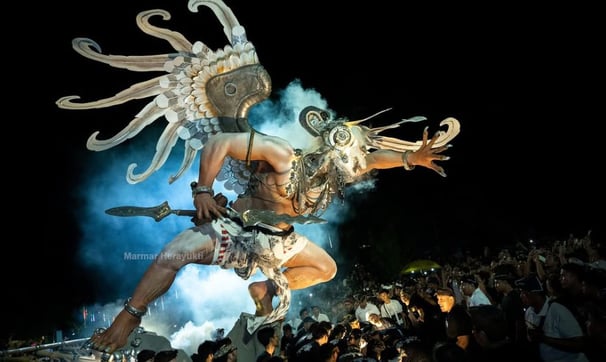Ogoh-Ogoh
CULTURE BALICOMMUNITY


Bali is globally renowned for its rich cultural tapestry, and one of its most spectacular and symbolic traditions is the Ogoh-Ogoh parade. Taking place on the eve of Nyepi, Bali’s Day of Silence, the Ogoh-Ogoh procession is a vibrant and dramatic cultural spectacle that reflects the island’s unique blend of Hindu beliefs, artistic expression, and community spirit.
What is Ogoh-Ogoh?
Ogoh-Ogoh are giant, often grotesque effigies crafted from bamboo, paper, and other lightweight materials. These statues depict evil spirits or mythological beings, often with exaggerated features like bulging eyes, fangs, and multiple arms. Some even portray modern “evils” such as corrupt politicians, environmental destruction, or social media addiction, giving the tradition a contemporary twist.
The name Ogoh-Ogoh is derived from the Balinese word “ogah-ogah,” meaning “to shake,” referring to the way these statues are carried through the streets — rocked back and forth to symbolize chaos and fear.
The Spiritual Meaning Behind Ogoh-Ogoh
The Ogoh-Ogoh represent Bhuta Kala, malevolent spiritual entities in Balinese Hinduism. These beings are believed to disrupt the harmony between nature, humans, and the divine. The act of building, parading, and symbolically destroying the Ogoh-Ogoh is meant to purify the environment from these negative energies and restore balance.
After months of preparation, the culmination of this ritual occurs on Tawur Kesanga, the day before Nyepi. As night falls, the statues are paraded through the village streets accompanied by gamelan music, torches, and traditional dances. It’s loud, energetic, and filled with the roar of the crowd — a sharp contrast to the complete silence that will follow the next day.
The Night Before Silence
The Ogoh-Ogoh parade is a final outburst of energy before the solemn observance of Nyepi. On Nyepi, the island shuts down entirely: no flights, no cars, no electricity, no entertainment — even locals stay home and refrain from work or travel. It’s a day dedicated to self-reflection, meditation, and spiritual cleansing.
But before this introspection comes the cleansing of the external world. The Ogoh-Ogoh are burned or destroyed at the end of the parade, symbolizing the elimination of negative forces. This fiery conclusion reminds everyone that in order to grow spiritually, we must first face and conquer the demons—both real and symbolic—around and within us.
More Than Just a Parade
For many Balinese youth, especially those in local creative groups (sekaa teruna), the Ogoh-Ogoh event is more than a spiritual duty — it’s an opportunity to showcase their artistic talent, teamwork, and pride in their culture. Months of planning and crafting are poured into these magnificent structures, turning villages into collaborative art studios and the streets into moving galleries.
Conclusion
The Ogoh-Ogoh tradition is one of the most powerful cultural expressions in Bali. It captures the island’s dedication to harmony, its creative spirit, and its deep-rooted belief in the balance between good and evil. Whether you’re a first-time visitor or a long-time resident, witnessing an Ogoh-Ogoh parade is an unforgettable experience that offers insight into the soul of Bali.


